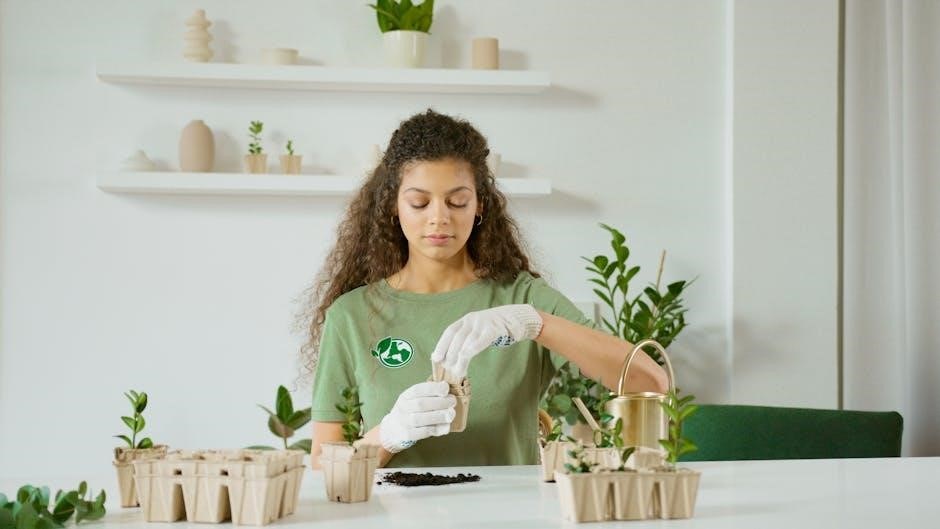
indoor plant care guide pdf
to caring for indoor plants, including tips and tricks for a healthy environment, using exactly always.
Importance of Indoor Plants
Indoor plants play a significant role in improving indoor air quality and making a home more inviting. They have the ability to purify the air, reducing toxins and pollutants, and creating a healthier environment. According to various studies, indoor plants can also have a positive impact on mental health, reducing stress and anxiety. Additionally, they can add a touch of natural beauty to a room, making it feel more welcoming and cozy. With the right care and attention, indoor plants can thrive and provide numerous benefits for occupants. By incorporating indoor plants into a home or office, individuals can create a more pleasant and healthy space. Indoor plants are a simple and effective way to improve the overall quality of a room, and with proper care, they can bring numerous benefits for years to come, using them effectively in a room.
Basic Aspects of Indoor Plant Care
Understanding the basic aspects of indoor plant care is crucial for the health and survival of plants. This includes providing the right amount of light, water, and nutrients. The type of light, whether natural or artificial, and the duration of exposure, can greatly impact plant growth. Watering is also essential, as overwatering can be detrimental to plants. The frequency of watering depends on the type of plant, soil, and climate. Nutrients, such as fertilizers, can be added to the soil to promote healthy growth. By familiarizing oneself with these basic aspects, individuals can create an ideal environment for their indoor plants to thrive. Proper care and attention can help prevent common problems, such as pests and diseases, and ensure the longevity of indoor plants, making them a beautiful and beneficial addition to any space, with proper maintenance and care always.

Care of Specific Plants
Providing specific care for various indoor plants requires knowledge of their unique needs, using guides and resources effectively always, every time, in every case, with .
Terrariums and Dish Gardens
Terrariums and dish gardens are unique and beautiful additions to any indoor space, requiring specific care and attention to thrive. Using a guide can help with the creation and maintenance of these miniature gardens. The key to success lies in selecting the right plants, soil, and containers, and understanding the importance of moisture and light. With proper care, terrariums and dish gardens can bring a touch of natural beauty to indoor spaces, purifying the air and improving the aesthetic. By following the tips and guidelines outlined in an indoor plant care guide, individuals can create and maintain stunning terrariums and dish gardens, enjoying the many benefits they provide, including improved air quality and a sense of tranquility, with the right techniques and materials, every time, always successfully.
Plant Lists and Additional Resources
For individuals looking to expand their indoor plant collection, plant lists and additional resources are invaluable tools. A comprehensive guide can provide access to extensive lists of plants, each with its own unique characteristics and care requirements. These resources can help individuals make informed decisions when selecting new plants, ensuring they choose varieties that thrive in their specific environment. Additional resources, such as online forums and plant care communities, can also provide a wealth of information and support, connecting individuals with experienced plant enthusiasts and experts. By utilizing these resources, individuals can gain a deeper understanding of indoor plant care, stay up-to-date on the latest trends and techniques, and enjoy the many benefits of indoor plants, including improved air quality and aesthetic appeal, with confidence and success, every time, always.

Basic Houseplant Care
Houseplant care involves understanding light and watering needs, using proper techniques always.
General Guide to Caring for Indoor Plants
A general guide to caring for indoor plants is essential for maintaining their health and longevity. This guide provides information on the basic needs of indoor plants, including light, water, and nutrients. By following these guidelines, indoor plants can thrive and bring numerous benefits to their owners. A well-cared-for indoor plant can improve air quality, reduce stress, and add aesthetic value to a room. The guide covers various aspects of indoor plant care, such as soil selection, fertilization, and pruning. It also discusses common problems that may arise, such as pests and diseases, and provides solutions to address these issues. With a general guide to caring for indoor plants, individuals can confidently select and care for the perfect plants for their homes or offices, and enjoy the many benefits they provide, using proper techniques and best practices always, for optimal results and plant growth.
Light and Watering Needs
Light and watering needs are crucial factors in indoor plant care, requiring attention to detail for optimal growth. The amount of light an indoor plant receives can affect its water requirements, with plants in brighter locations needing more frequent watering. A general rule of thumb is to water indoor plants when the top inch of soil feels dry to the touch. Overwatering can be detrimental to indoor plants, leading to root rot and other problems. Conversely, underwatering can cause plants to become stressed and susceptible to disease. By understanding the specific light and watering needs of their indoor plants, individuals can create a thriving environment, using techniques such as monitoring soil moisture and adjusting watering schedules accordingly, to ensure their plants receive the right amount of water and light, promoting healthy growth and development always, with proper care and attention. Proper watering techniques are essential for indoor plant care.

Plant Care Guide for Specific Plants

A guide for specific plants provides detailed information on caring for unique species, using exactly always, with proper care techniques and methods for optimal growth and development, every day.
Chinese Money Plant Care
The Chinese Money Plant is a popular indoor plant, and its care involves providing the right amount of light and water. According to the indoor plant care guide pdf, this plant prefers bright indirect light, but can tolerate low light conditions. The watering needs of the Chinese Money Plant are moderate, and it should be watered when the soil is partially dry. A general guide to caring for this plant includes fertilizing it during the growing season and pruning it to maintain its shape. The Chinese Money Plant is also susceptible to pests and diseases, and regular inspection is necessary to prevent infestations. With proper care, the Chinese Money Plant can thrive indoors, and its unique leaves can add a touch of elegance to any room. By following the care tips outlined in the guide, you can keep your Chinese Money Plant healthy and happy.
Plant Needs and Challenges
Indoor plants have specific needs and challenges that must be addressed to ensure their survival and thriving. The indoor plant care guide pdf outlines the common challenges faced by indoor plants, including pests, diseases, and environmental stressors. Plants require adequate light, water, and nutrients to grow and develop, and a lack of these essential elements can lead to decline and death. Additionally, indoor plants are often susceptible to temperature fluctuations, low humidity, and poor air quality, which can exacerbate existing problems. By understanding the specific needs and challenges of indoor plants, caregivers can take proactive steps to prevent problems and create a healthy and thriving environment. Regular monitoring and maintenance are crucial to identifying and addressing potential issues, and the guide provides valuable tips and advice for overcoming common challenges and keeping indoor plants happy and healthy. Proper care is essential for plant survival.